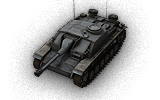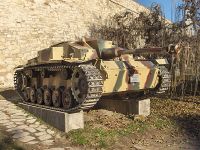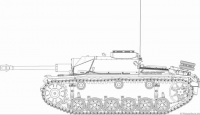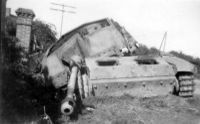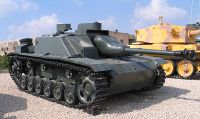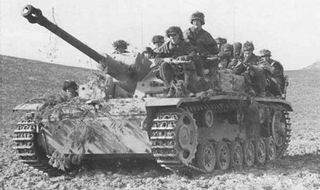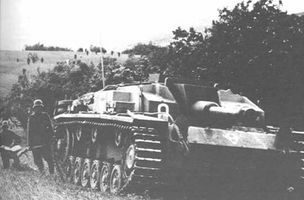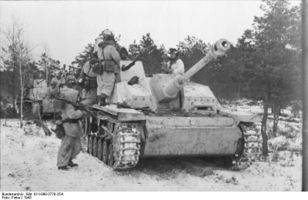StuG III
The Sturmgeschutz III is a German Tier V Tank Destroyer. The StuG III was designed as an Assault Gun based off the Panzer III chassis, meant to provide close support to infantry in situations where greater armor and firepower were needed. As World War II progressed and Germany lost material and resources, the StuG III was pushed into a Tank Destroyer role, and in this role proved to be the most effective Tank Destroyer in the German arsenal, if not the most effective Tank Destroyer of all nations during the war. Roughly 10,000 StuG III's were produced from January 1940 through the end of the war in 1945. Additionally, roughly 1,300 Sturmhaubitze 42 variants were produced as well. The StuG III is a highly maneuverable and versatile tank, able to play the role of a sniper using the 7,5cm L/70, or as a close support and ambush vehicle using the 10,5cm L/28. The StuG III is one of the better Tier V vehicles and a force to be reckoned with. The StuG III leads to the Jagdpanzer IV.
Compatible Equipment
Compatible Consumables
Player Opinion
Pros and Cons
Pros:
- Excellent Camouflage Rating; one of the highest in the game
- Excellent Aim Time on all guns
- Excellent Gun in the 10,5cm L/28; best Rate of Fire for a howitzer in Tier V, excellent Aim Time, excellent Alpha DMG, excell
- Excellent Gun in the 7,5cm L/70; excellent Accuracy, excellent Aim Time, great Penetration, good Rate of Fire, good Alpha DMG
- Excellent Mobility; highest Track Traverse of all Tier V TD's, 2nd highest Acceleration, and good Top Speed
Cons:
- Very low ammo capacity for both the 7,5cm L/70, but especially the 10,5cm L/28
- Low View Range; Optics or Binocs are recommended
- Weak side and rear armor
- Lower glacis plate, like many German tanks, is prone to engine damage or fire when shot
- Low hit points
Performance
There are two ways to play the StuG III, thanks to the 7,5cm L/70 and 10,5cm L/28.
When using the 7,5cm L/70: You will want to play as a true sniper staying well back from the front lines, within and behind bushes preferably. Let other tanks spot targets for you and provide precision shots from safety. Find a position on the map where your gun will be of the most use, while allowing you to stay safe and hidden, and use your great mobility to relocate as needed. Be mindful of your low ammo capacity and pick quality shots.
When using the 10,5cm L/28: Due to the lack of accuracy you will want to play closer up, in a more support role. This doesn't mean you should abandon concealment and cover, only that you should find such things closer to the front line. When possible, flank enemies who are distracted to get in easy side shots, and in city maps don't be afraid to play the tank like a Medium. Be mindful of your low ammo capacity and pick quality shots.
If you're top tier, be aggressive. While you don't have the greatest armor nor hit points, the mobility of the StuG combined with the potency of it's guns allows it to operate as a pretty good skirmisher; hit fast, hit hard, get out quickly.
All in all, when the StuG is played well, it is easily one of the best Tier V vehicles in the game and can handle itself well even in Tier VII.
Historical Info
The Sturmgeschütz III (StuG III) assault gun was Germany's most produced armored fighting vehicle during World War II. It was built on the chassis of the proven Panzer III tank. Initially intended as a mobile, armored light gun for infantry support, the StuG was continually modified and widely employed as a tank-destroyer.
Development
The Sturmgeschütz III originated from German experiences in World War I, when it was discovered that during the offensives on the western front, the infantry lacked the means to effectively engage fortifications. The artillery of the time was heavy and not mobile enough to keep up with the advancing infantry to destroy bunkers, pillboxes, and other minor obstacles with direct-fire. Although the problem was well-known in the German army, it was General Erich von Manstein, who is considered the father of the Sturmartillerie, that saw the solution. The initial proposal was from (then) Colonel Erich von Manstein, and submitted to General Ludwig Beck in 1935, suggesting that Sturmartillerie ("assault artillery") units should be used in a direct-fire support role for infantry divisions. On June 15, 1936, Daimler-Benz AG received an order to develop an armored infantry-support vehicle capable of mounting a 75 mm (2.95 in) artillery piece. The gun mount's fixed, fully-integrated casemate superstructure was to allow a limited traverse of a minimum of 25° and provided overhead protection for the crew. The height of the vehicle was not to exceed that of the average man. Daimler-Benz AG used the chassis and running gear of its recently designed Pz.Kpfw. III medium tank as a basis for the new vehicle. Prototype manufacture was passed over to Alkett, which produced five examples in 1937 of the experimental 0-series StuG based upon the Pz.Kpfw. III Ausf. B. These prototypes featured a mild-steel superstructure and Krupp’s short-barreled 75 mm StuK 37 L/24 cannon. This model was known as the Sturmgeschütz Ausführung A.
While the StuG III was considered self-propelled artillery, it was not initially clear which arm of the Wehrmacht would handle the new weapon. The Panzer arm, who was the natural user of tracked fighting vehicles, had no resources to spare for the formation of StuG units, and neither did the infantry branch. It was agreed, after a discussion, it would best be employed as part of the artillery arm.
The StuGs were organized into battalions (later renamed "brigades" for disinformation purposes) and followed their own specific doctrine. Infantry support using direct-fire was its intended role. Later, there was also a strong emphasis on destroying enemy armor whenever encountered. As the StuG III was designed to fill an infantry close support combat role, early models were fitted with a low-velocity 75 mm StuK 37 L/24 gun to destroy soft-skin targets and fortifications. After the Germans encountered the Soviet KV-1 and T-34 tanks, the StuG III was equipped with a high-velocity 75 mm StuK 40 L/43 main gun (Spring 1942) and later, the 75 mm StuK 40 L/48 (Autumn 1942) anti-tank gun. These versions were known as the Sturmgeschütz 40 Ausführung F, Ausf. F/8, and Ausf. G. When the StuG IV entered production in late 1943 and early 1944, the "III" was added to the name to separate it from the Panzer IV-based assault guns. All previous and following models were thereafter known as Sturmgeschütz III.
Beginning with the StuG III Ausf. G, a 7.92 mm MG34 could be mounted on a shield on top of the superstructure for added anti-infantry protection from December 1942. Some of the F/8 models were retrofitted with a shield as well. Many of the later StuG III Ausf. G models were equipped with an additional coaxial 7.92 mm MG34. The vehicles of the Sturmgeschütz series were cheaper and faster to build than contemporary German tanks; at 82,500 RM, a StuG III Ausf G was cheaper than a Panzer III Ausf. M, which cost 103,163 RM. This was due to the omission of the turret, which greatly simplified manufacture and allowed the chassis to carry a larger gun than it could otherwise. By the end of the war, 10,619 StuG IIIs and StuH 42s had been built.
Operational history
Overall, Sturmgeschütz-series assault guns proved very successful and served on all fronts as assault guns and tank-destroyers. Although Tigers and Panthers have earned a greater notoriety, assault guns collectively destroyed more tanks. Because of their low silhouette, StuG IIIs were easy to camouflage and a difficult target. Sturmgeschütz crews were considered to be the elite of the artillery units. Sturmgeschütz units held a very impressive record of tank kills: some 20,000 enemy tanks by the spring of 1944. As of April 10, 1945, there were 1,053 StuG IIIs and 277 StuH 42s in service. Approximately 9,500 StuG IIIs of various types were produced until March 1945 by Alkett and a small number by MIAG.
In terms of the resources expended in their construction, the StuG assault guns were extremely cost-effective compared to the heavier German tanks, though in the anti-tank role, it was best used defensively, as the lack of a traversable turret would be a severe disadvantage in the assault role. As the German military situation deteriorated later in the war, more and more StuG guns were constructed in comparison to tanks: an effort to replace losses and bolster defences against the encroaching Allied forces.
In 1944, the Finnish Army received 59 StuG III Ausf. Gs from Germany (30 Stu 40 Ausf.G and 29 StuG III Ausf. G) and used them against the Soviet Union. These destroyed at least 87 enemy tanks for a loss of only 8 StuGs[2] (some of these were destroyed by their crews to avoid capture). After the war, they were the main combat vehicles of the Finnish Army until the early 1960s. These StuGs gained the nickname "Sturmi" which can be found in some plastic kit models.
100 StuG III Ausf. G were delivered to Romania in the autumn of 1943. They were officially known as TAs (or TAs T3 to avoid confusion with TAs T4) in the army inventory. By February 1945, 13 units were still in use with the 2nd Armored Regiment. None of this initial batch survived the end of the war. 31 TAs were on the army inventory in November 1947. Most of them were probably StuG III Ausf. Gs and a small number of Panzer IV/70 (V)s, known as TAs T4s. These TAs were supplied by the Red Army or were damaged units repaired by the Romanian Army. All German equipment was scrapped in 1954 due to the Army's decision to use Soviet armor. StuG IIIs were also exported to other nations such as Bulgaria, Hungary, Italy, and Spain.
Many German Sturmgeschütz IIIs were captured by Yugoslav Partisans. After the war, they were used by the Yugoslav Peoples Army until the 1950s.
After the Second World War, the Soviet Union donated some of their captured German vehicles to Syria, which continued to use them, along with other war surplus AFVs (like long-barreled Panzer IVs and T-34/85s), during the fifties and up until the The War over Water against Israel in the mid 60s. By the time of the Six Days War, all of them had been either destroyed, stripped for spare parts, or interred on the Golan Heights as static pillboxes.
Historical Gallery
Sources and External Links
| Light Tanks | |
| Medium Tanks | |
| Heavy Tanks | |
| Tank Destroyers | |
| Self-Propelled Artillery |
| USA | |
| UK | |
| Germany | |
| France | |
| USSR | |
| China | |
| Japan | |
| Czechoslovakia | |
| Sweden |
